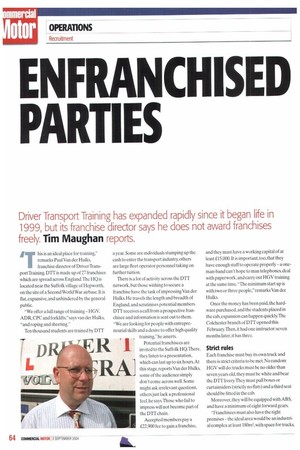ENFRAI■ICHISED PARTIES
Page 64

Page 65

If you've noticed an error in this article please click here to report it so we can fix it.
Driver Transport Training has expanded rapidly since it began life in 1999, but its franchise director says he does not award franchises
freely. Tim Maughan reports.
,T his is an ideal place for training," remarks Paul Van der Hulks, franchise director of Driver Transport Training. DTT is made up of 27 franchises which are spread across England.The HQ is located near the Suffolk village of Hepworth, on the site of a Second World War airbase. It is flat, expansive, and unhindered by the general public.
"We offer a full range of training— HGV, ADR, CPC and forklifts," says van der Hulks, "and roping and sheeting."
Ten thousand students are trained by DTT a year. Some are individuals stumping up the cash to enter the transport industry, others are large fleet operator personnel taking on further tuition.
There is a lot of activity across the DTI' network, but those wishing to secure a franchise have the task of impressing Van der Hulks. He travels the length and breadth of England, and scrutinises potential members. urr receives a call from a prospective franchisee and information is sent out to them. "We are looking for people with entrepreneurial skills and a desire to offer high quality training," he asserts.
Potential franchisees are invited to the Suffolk HQ.There, they listen to a presentation, which can last up to six hours. At this stage, reports Van der Hulks, some of the audience simply don't come across well. Some might ask irrelevant questions, others just lack a professional feel, he says. Those who fail to impress will not become part of the DTT chain.
Accepted members pay a £22,900 fee to gain a franchise, and they must have a working capital of at least £15,000. It is important, too,that they have enough staff to operate properly — a oneman-band can't hope to man telephones, deal with paperwork, and carry out HGV training at the same time. "The minimum start up is with two or three people," remarks Van der Hulks.
Once the money has been paid, the hardware purchased. and the students placed in the cab, expansion can happen quickly.'The Colchester branch of DlT opened this February. Then, it had one instructor: seven months later, it has three.
Strict rules
Each franchise must buy its own truck and there is strict criteria to be met. No random HGV will do: trucks must be no older than seven years old, they must be white and bear the DTT livery.They must pull boxes or curtainsiders (strictly no flats) and a third seat should be fitted in the cab.
Moreover, they will be equipped with ABS, and have a minimum of eight forward gears.
"Franchisees must also have the right premises — the ideal area would be an industrial complex at least 180m7, with space for trucks, forklifts. classrooms, offices and a restroom."
HGV driver training outfits can exist in their own right, and never have to be part of a franchised network. So why join the likes of DTT? "Recognition,states Van der Hulks. It is true that national networks of any type loom larger than small, independent firins.
He stresses that DTT actively seeks to place successful students into transport jobs. Each year, the DTT franchise network pays £0.5m in test fees.
After an individual franchise has paid the joining fee, it is bound to pay 8% of its monthly sales to DTT head office. Franchise contracts are awarded on a five-year basis.
The training process is the core of the business here, but nothing happens without the franchising programme. Van der Hulks conducts a brief tour of the site. He shows us an IT room: the computers here are used to train students for theory tests. Other rooms are dedicated to administering the UK franchise process Then, we take a quick look at a large classroom and, after that, he leads us to the manoeuvring area.There, we see students being instructed about how to handle a rigid. A large shed stands behind the area.This building is used to train forklift drivers.
DTT intends to expand its franchise base, which means that Van der Hulks is busy. It is not just a matter of attracting new franchisees. Existing members sometimes need advice and support.
He says that the network has enjoyed "phenomenal growth" since it was established. It has been an impressive rise, but Van der Hulks is quick to point out that such expansion can only be sustained by maintaining high standards.
"There are good and bad training companies. We are not out there to be mercenary, we are here to support the industry," he says. Bad training companies, believes Van der Hulks.fall down because their trainers might be poorly dressed, or they might operate below-par vehicles. DTI' members must tow the line:The highlights of the job for Van der Hulks? "Meeting such a vast array of people, and being able to see the franchisees."
DTT intends to spread its wings still further: "We want to continue to expand, we want to move into Scotland and Wales and mainland Europe." •




























































































































































































